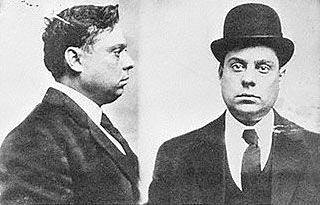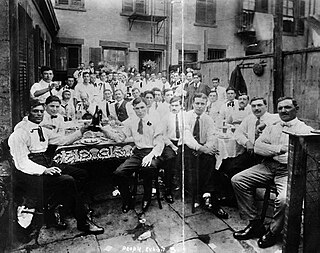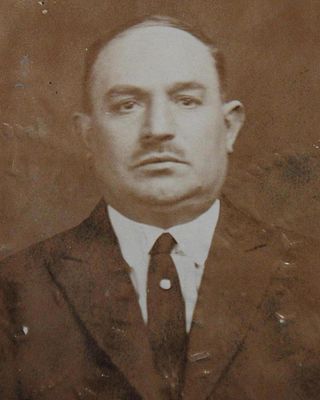
Selmer is a City in and the county seat of McNairy County, Tennessee, in the southwestern part of the state. The population was 4,446 as of the 2020 census. It is named after Selma, Alabama.
Continental philosophy is an umbrella term for philosophies prominent in continental Europe. Michael E. Rosen has ventured to identify common themes that typically characterize continental philosophy. These themes proposed by Rosen derive from a broadly Kantian thesis that knowledge, experience, and reality are bound and shaped by conditions best understood through philosophical reflection rather than exclusively empirical inquiry.

Giuseppe "Joe the Boss" Masseria was an early Italian-American Mafia boss in New York City. He was boss of what is now called the Genovese crime family, one of the New York City Mafia's Five Families, from 1922 to 1931. In 1930, he battled in the Castellammarese War to take over the criminal activities in New York City. The war ended with his murder on April 15, 1931, in a hit ordered by his own lieutenant, Charles "Lucky" Luciano, in an agreement with rival faction head Salvatore Maranzano.

"The Two Cultures" is the first part of an influential 1959 Rede Lecture by British scientist and novelist C. P. Snow, which was published in book form as The Two Cultures and the Scientific Revolution the same year. Its thesis was that science and the humanities, which represented "the intellectual life of the whole of western society", had become split into "two cultures" and that this division was a major handicap to both in solving the world's problems.
The Castellammarese War was a bloody power struggle for control of the American Mafia between partisans of Joe "The Boss" Masseria and Salvatore Maranzano that took place in New York City from February 1930, until April 15, 1931. The feud was named after the Sicilian town of Castellammare del Golfo, Maranzano's birthplace.

Crossley Motors was an English motor vehicle manufacturer based in Manchester, England. It produced approximately 19,000 cars from 1904 until 1938, 5,500 buses from 1926 until 1958, and 21,000 goods and military vehicles from 1914 to 1945.

The C class was a class of 32 destroyers of the Royal Navy that were launched from 1943 to 1945. The class was built in four flotillas of 8 vessels, the "Ca", "Ch", "Co" and "Cr" groups or sub-classes, ordered as the 11th, 12th, 13th and 14th Emergency Flotillas respectively. The sub-class names are derived from the initial 2 letters of the member ships' names, although the "Ca" class were originally ordered with a heterogeneous mix of traditional destroyer names. A fifth flotilla, the "Ce" or 15th Emergency Flotilla, was planned but were cancelled in favour of the Weapon-class destroyers after only the first two ships had been ordered. The pennant numbers were all altered from "R" superior to "D" superior at the close of World War II; this involved some renumbering to avoid duplications.

Ignazio Lupo, also known as Ignazio Saietta and Lupo the Wolf, was a Sicilian American Black Hand leader in New York City during the early 1900s. His business was centered in Little Italy, Manhattan, where he ran large extortion operations and committed other crimes including robberies, loan-sharking, and murder. By the start of the 20th century, Lupo merged his crew with others in the South Bronx and East Harlem to form the Morello crime family, which became the leading Mafia family in New York City.

Simon Critchley is an English philosopher and the Hans Jonas Professor of Philosophy at the New School for Social Research in New York, USA.

Macdonald Critchley CBE was a British neurologist. He was former president of the World Federation of Neurology, and the author of over 200 published articles on neurology and 20 books, including The Parietal Lobes (1953), Aphasiology, and biographies of James Parkinson and Sir William Gowers.

The Highway of Tears is a 719-kilometre (447 mi) corridor of Highway 16 between Prince George and Prince Rupert in British Columbia, Canada, which has been the location of crimes against many women, beginning in 1970 when the highway was completed. The phrase was coined during a vigil held in Terrace, British Columbia in 1998, by Florence Naziel, who was thinking of the victims' families crying over their loved ones. There are a disproportionately high number of Indigenous women on the list of victims, hence the association with the Missing and Murdered Indigenous Women (MMIW) movement.
Salvatore "Toto" D'Aquila was an early Italian-American Mafia boss in New York City of the D'Aquila crime family, what would later become known as the Gambino crime family.
Buster from Chicago was a pseudonym used for a mobster and freelance hitman of the 1930s. He is alleged to have played a key role in the Castellammarese War (1929–1931) as the assassin of Giuseppe Morello and others. Some claim that Buster was gangster Sebastiano Domingo (1910–1933), notably Bill Bonanno, the son of Bonanno crime family leader Joseph Bonanno, who participated in the War. Others charge that Buster is a character created by Joe Valachi to evade his responsibility for various killings.

Gaetano Reina was an Italian-American gangster. He was an early American Mafia boss who was the founder of what has for many years been called the Lucchese crime family in New York City. He led the family until his murder on February 26, 1930, on the orders of Joe Masseria.

Port Davey is an oceanic inlet located in the south west region of Tasmania, Australia.
Jason Critchley is an English former professional rugby league and rugby union footballer who played the 1980s, 1990s and 2000s. At club level for the Castleford Tigers, Keighley Cougars, Salford City Reds, Wakefield Trinity Wildcats, Whitehaven and the Widnes Vikings as a wing or centre, and top level club level rugby union for Newport RFC, Leicester Tigers, Manchester (loan), US Dax and De La Salle Palmerston.

When a Crocodile Eats the Sun is a 2006 book of memoirs by Peter Godwin. It is a continuation of Godwin's earlier memoirs, Mukiwa. The book was published by Picador.
Gary Critchley is a British man who was convicted of murder in 1981 and ultimately released in 2012, having continuously maintained his innocence.

The Brooklyn Camorra or New York Camorra was a loose grouping of early-20th-century organized crime gangs that formed among Italian immigrants originating in Naples and the surrounding Campania region living in Greater New York, particularly in Brooklyn. In the early 20th century, the criminal underworld of New York City consisted largely of Italian Harlem-based Sicilians and groups of Neapolitans from Brooklyn, sometimes referred to as the Brooklyn Camorra, as Neapolitan organized crime is referred to as the Camorra.

Nicolo "Cola" Schiro was an early Sicilian-born New York City mobster who, in 1912, became the boss of what later become known as the Bonanno crime family.














